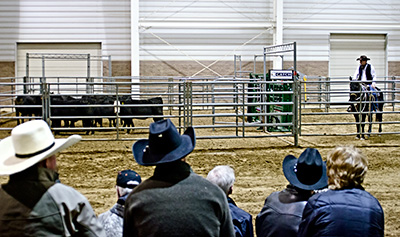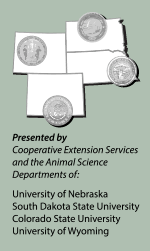Stockmanship & Stewardship
It’s all about pressure and creating an understanding between man and beast.
LOVELAND, Colo. (Nov. 16, 2015) — “Stockmanship to me is like a highway roundabout,” says Curt Pate, a well-known livestock-handling specialist. He explained that those circular intersections make people think as they navigate through the curves and outlets.
Likewise, Pate says, “Stockmanship while working with livestock is kind of a roundabout. You’ve got to think. It’s tough. It’s a skill.”
Pate presented his thoughts and techniques during a Beef Quality Assurance (BQA) pre-symposium event Nov. 16, 2015, which was a precursor to the 24th Range Beef Cow Symposium hosted Nov. 17-19 at The Ranch, Loveland, Colo.

Curt Pate presented his thoughts and techniques during a Beef Quality Assurance (BQA) pre-symposium event Nov. 16, 2015.
Regarding the value of stockmanship, Pate noted, “It’s not only about working animals; it’s about understanding animals. You need to be able to look at animals and know if they are content – if they have what they need.”
He added, “The more you think and work at it and analyze your efforts after you get done working with a group of livestock, the better you’ll become, and it’ll improve your quality of life and improve our quality of beef.”
One of Pate’s fundamental techniques is the use of pressure.
“Pressure is what stimulates animals to move,” he says, using the analogy of the pressure of a storm that prompts animals to move forward to seek shelter.
“It’s all about putting yourself in the right place at the right time with the animals to give the right amount of pressure, and then releasing animals to do what you’ve asked them to do,” he explains.
Rather than “low-stress handling,” Pate prefers terms like “good-flow handling” and “effective stockmanship.” He notes that in some situations, such as moving cattle into a chute or semi-trailer, more pressure may be needed. He emphasizes that you do not want to panic the animals, but you may need to increase the pressure being applied to keep them moving.
“When cattle are too gentle, it makes them more difficult to move,” he shares, noting, “I’m not against hot shots. I think they are one of the most humane tools we have if they are used properly.”
The mood of the people working the cattle can influence their movement and reactions, Pate emphasized. “I believe cattle can read people better than we can read them.”
He tells the story of a producer who was mad while sorting cattle and the cattle would not go by him. Pate says, “Fear, anger, whatever it is that is affecting your mood, cattle pick up on that. So it is real important to keep your attitude right while working with livestock.”
Editor’s Note: This summary was written under contract or by staff of the Angus Journal®, which retains the copyright. To request to reprint this article, contact Shauna Rose Hermel, editor, at 816-383-5270. PowerPoints are posted with permission of the presenter and may not be reproduced in whole or in part without the express permission of the presenter. Angus Journal claims copyright to this web site as presented. We welcome educational venues and cattlemen to link to this site as a service to their audience.
The Angus Journal's coverage of the event is made possible through collaboration with the event committee and sponsorship of LiveAuctions.tv. For questions about this site, or to notify us of broken links, click here. Look for additional coverage in the Angus Journal, the Angus Beef Bulletin, the Angus Journal Daily, the Angus Beef Bulletin EXTRA and Angus TV.


